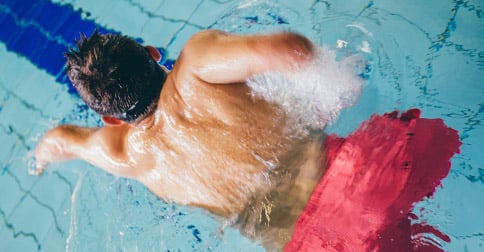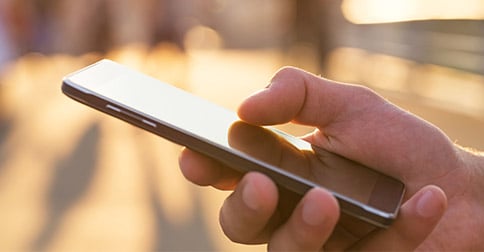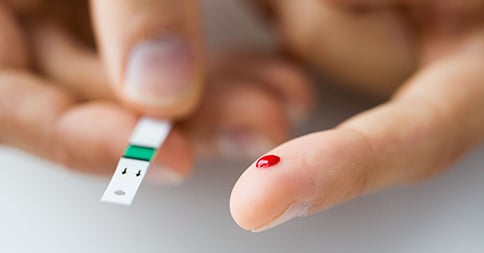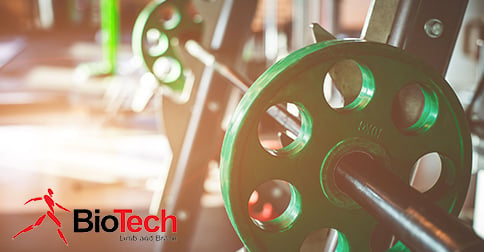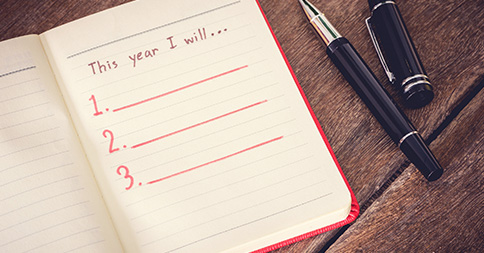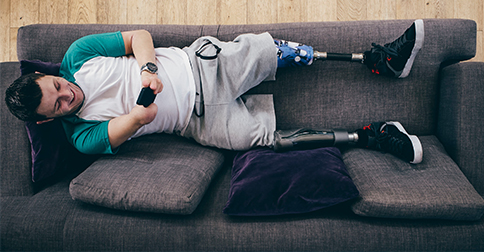The Grand Slam Tennis Tournament is about to enter its second stage at the Roland Garros in Paris. After that, it will proceed to New York City for the US Open. While we watch these great players perform, we can also spend some time playing ourselves--even if we’ve experienced limb loss.
Fortunately, playing tennis with a prosthetic leg is fairly easy to do. Whether you are playing competitively or just hitting the ball around with friends, learn how to stay comfortable while playing and find out the right equipment to use.
Why Tennis?
Tennis is a perfect activity for someone who has experienced limb loss and is trying to become more active. You obviously need to feel comfortable being active in your prosthesis already, but playing tennis will help you handle turns, short sprints, and pivots while allowing you to enjoy yourself at the same time.
You can also play at the speed you choose, whether it’s soft lobs back and forth with a friend or a more competitive speed round. Start slow, get acquainted, and see if this is the sport for you. For those who enjoy it, there are tennis clubs across the country that you can play in, and specialized camps for those looking to play other adaptive tennis players.
Preparing
As we said earlier, a large positive of playing tennis is the ability to choose your own pace. The quality of your equipment will change as you become a more active player. Some ways you can help yourself adjust to being more physically active are frequently exercising your core, discussing the parts of your prosthesis with your specialist, and joining a group to motivate you to continue playing. Practice moving in a controlled environment to get adjusted to your equipment and make sure it fits well for physical activity.
Equipment
Fortunately, we live in a time where technology for limb loss is improving every day. Talk to your prosthetist and let them know what you are trying to accomplish, and they will help you find the right fit for you. There is a wide range of athletic prosthetics available, and it is important to match the one that fits you and your goals the best. If you get a new prosthesis, it is important to wear it in for a bit before using it competitively.
Let BioTech Help!
BioTech specializes in using the best and most up-to-date technology to make your everyday life as simple as possible. This includes hobbies and sports like tennis. We want to make sure you have the most comfortable and quality prosthesis, and we will work with you to make sure you achieve everything you want to accomplish. Contact us for more information.
We’re thrilled about observing Limb Loss Awareness Month 2017, and we’re ready to help make it the best one yet! Keep reading below to find out how you can be a part of this very exciting month.
Hill Day
Come to Washington, D.C. from April 25-26 and talk to your elected officials about issues that have an effect on those with limb loss. Training and networking starts at noon on the 25th, and legislator visitation takes place on the 26th. Among other things, we’ll be addressing insurance fairness for amputees, funding for programs and research that improves life for someone with limb loss, and more. Get more details here.
Harness the Power of Social Media
We all know social media can be an incredibly effective tool for spreading the word about… well, anything. Download the Amputee Coalition toolkit and dedicate your social network pages to Limb Loss Awareness Month! With premade graphics, flyers, and more, you’ll have everything you need to make sure all your friends know how special this month is.
Show Your Mettle
Definitely one of the most loved traditions of LLAM, this is a great opportunity to show exactly what you’re made of!
Step 1: Take a photo of yourself that showcases your limb loss.
Step 2: Post it with the hashtag #ShowYourMettle, and let your unstoppable spirit shine!
Book a Speaking Engagement
Whether at your local library, civic group, or church, April is a great month to speak about limb loss and everything it entails. Reach out to organizations around your city and ask them if they’d be interested in having you come speak. Then, use that opportunity to educate the public about limb loss and encourage them to get involved with their elected officials to help amputees live well!
Need More Tips for Limb Loss Awareness Month?
If you’re looking to get involved but you’re not sure how to take the first step, contact BioTech. We love our patients like family, and we’ll do anything to make sure they are loved and celebrated during the month of April (and every other month, for that matter). Contact us today for more information on limb loss, prosthetic devices, and more!
After you lose a limb, you may feel like all the goals you had set for yourself are no longer viable. The truth, though, is that there’s usually a way to continue with your passions and dreams, even after an amputation. Read on!
Goal Adaptation
Let’s say your goal was to climb Mount Everest this year, but now you’re a double leg amputee and you feel like the dream is impossible. Maybe, instead of giving up altogether, you adapt your goal to fit your new situation.
Instead of climbing Mount Everest this year, give yourself a few years to get more comfortable with leg prostheses and work your way up to Mount Everest. Start with a small mountain and see how it goes. Then try a slightly larger one. Always keep a friend or two with you, and make sure you have all the necessary gear to do this successfully – and before you know it, you’ll be tackling your dream mountain as a double amputee!
New Goals
Limb loss actually opens up a whole new world of potential goals. Now, whatever you do, you’ll be doing it as an amputee – and you’ll be amazed at how much you can accomplish and how many people admire your persistence.
If your former goal seems too unlikely now, or you’re just not feeling inspired by it anymore, who says you can’t pick a new one? Take up something that interests you and feels more manageable, and then come back to your old goal in the future if you decide you want to!
Former Impossibilities Are Now Possible!
Always wanted to be a motivational speaker, but you never had a platform? Now you do! Consider all the things you weren’t a good candidate for before your limb loss, and then think about whether your amputation has changed that. People who overcome great challenges have lots of opportunities for speaking engagements, school involvement, and even new career paths.
Once you start recognizing all your possibilities, you’ll be setting and achieving goals in no time!
Need Advice for Setting Goals after Limb Loss? Call BioTech!
We love our patients like family – and that means we’re always here to talk, listen, or offer advice. Contact us today for more information on our services and how we can help you reach the stars!
Smartphones have a way of making our lives a little easier (well, except when they decide not to work correctly), and that’s also true for people with limb loss. When you’re trying to get back into some kind of routine, it can be helpful to have a handy app on your side, making the road to recovery just a little bit smoother.
Take a look at these apps for people with limb loss, and search for them in your phone’s app store!
Fitness for Amputees
This app calls itself “your portable personal fitness trainer” and offers exercises that are easy to understand, with video examples, that have been developed by an Ottobock physiotherapist. With 3 levels to progress through, this app should be useful for you for a while.
Here at BioTech, we believe that exercise is an essential part of recovery after limb loss. That’s why we think any app that encourages you to challenge yourself and reach your goals is great! If you need a starting point, check out this app, and see if it’s something that appeals to you.
Amputee Coalition inMotion
inMotion Magazine, published 6 times per year, is made especially for people with limb loss and their families. It provides timely, essential information on living with limb loss, and seeks to empower those who’ve become amputees.
So why do we think a magazine app is useful? Because it encourages things we believe in: community, education, and possibilities. When you’re reading about other people with limb loss, and the possibilities you can recognize when you’re inspired by other people, it can do a lot for your mental and emotional state. So we think this app is a great option!
Need More Resources? Contact Us Today!
One of our favorite things about what we do is working with patients – encouraging them, helping them get a great fit with their prosthesis, and giving them the tools they need to find a sense of normalcy. If you are in need of resources like this, please contact us today – we’re always ready to help!
The American Diabetes Association observes a number of wellness days throughout the year. This month, they will hold American Diabetes Association Alert Day – a one-day event that highlights methods of reversing the risk for diabetes and encourages people from all walks of life to take the Type 2 Diabetes Risk Test.
With an estimated 86 million Americans living with prediabetes – 90% of which have no idea that they have it – American Diabetes Association Alert Day is more important now than ever before.
Here are a few ways you can get involved!
Educate Loved Ones about Prediabetes
As the name implies, prediabetes is the condition that comes before full-blown type 2 diabetes. Many people are living with this condition – but they may have no idea that they have it, and so they don’t do anything to reverse it. Other people know they have it, but they’re not aware that they can do something to help, or they don’t think it’s worth changing their lifestyle for.
Type 2 diabetes comes with a lot of serious complications. Fatigue, blurry vision, and cuts or sores that won’t heal are just a few of the symptoms of this condition, and although it’s historically a disease that affects those over 40, it’s starting to show up in younger people – even children.
If your friend or loved one is overweight, sedentary, suffers from high blood pressure, has a family history of type 2 diabetes, is from an ethnic group that has a higher risk for type 2 diabetes, has low good cholesterol levels, or has high triglyceride levels, it’s essential that you talk to them about improving or maintaining their health.
Be Proactive
To start a conversation with your friends, family members, or coworkers, download the e-toolkit for American Diabetes Association Alert Day from the American Diabetes Association website. The toolkit includes social media messages and images, customizable posters, steps for success, and much more.
With type 2 diabetes, time is of the essence. Changes must be made now in order to prevent costly, troublesome, and dangerous health complications down the line.
Why Is BioTech So Passionate about American Diabetes Association Alert Day?
Here at BioTech Limb & Brace, we work with a lot of people who have diabetes and need special diabetic shoes. However, selling diabetic shoes to as many people as possible isn’t our focus – our goal is to help people live a long, enjoyable, fulfilling life.
Do we help people with diabetes live comfortably, and do we take great care of them? Of course. But we’re also passionate about the health and wellbeing of our patients – and if there’s a way to help them avoid type 2 diabetes, we’re all about it!
Contact us today for more information on foot orthotics, prosthetic devices, and more.
After limb loss, the journey back to your confidence can seem like a twisting, rocky path. But it’s a journey worth taking, and BioTech has 3 tips to help you regain confidence after limb loss!
Tip #1: Think Positive
Okay, we know – this one sounds too simple and cliché. But here’s the thing – scientists have actually discovered that positive and negative thoughts have totally different pathways through your brain. Without getting into the nitty gritty details, positive thoughts must be filtered before they are processed, whereas negative thoughts have a green light without filters. That means you’re not the only one whose thoughts go negative first – and it takes actual effort to think in a positive way.
Tip #2: Challenge Yourself and Make Goals
Sitting around all day thinking about how un-confident you feel isn’t going to change a thing! Instead, try setting some attainable goals for yourself and stretching your abilities a little bit each day. Achieving things, and feeling like you have made progress, will go a long way in increasing your self-confidence and your positive outlook on the future!
Tip #3: Think about the Root of Your Confidence Issues
Even after you start to feel more confident, you’ll probably have days where you fall into a “funk.” That’s normal for anyone, not just people with limb loss! But if it lasts longer than you think it should, try to pinpoint the cause of it. What are you believing about yourself? What are you thinking about others’ opinions of you? Is there an action step you need to take – something as simple as getting out of the house, or something as radical as switching careers? Consider the source of why you’re feeling down, and then think about how you might make a positive change.
Need Someone in Your Corner? Call BioTech!
Whether you’re looking for an expedited fitting for your prosthetic device, or you just need someone to answer a few questions, BioTech is always ready to treat you like family. Contact us today for more information on how we can help you recognize all the possibilities in your life!
If you’re interested in CrossFit, you may be feeling a strange mixture of intrigue and intimidation. Will the other CrossFitters accept you? Will the trainers be able to help you? How are you even going to do this?!
While everyone’s experiences are different, it is possible to start CrossFit after limb loss – and to find the courage to get active again!
Determine Your Goals
Before you actually go to a CrossFit gym, give them a call and explain your situation. The coaches will ask you about what you think you can do, what you are struggling with, and what you are looking to get out of your CrossFit experience.
Here are some ideas for goals to get you started:
- Be able to stand for a certain amount of time without pain
- Improve balance and control
- Walk without limping
Obviously, these goals are great for those who are using a leg prosthesis, but your goals may be different. Come up with a few goals that make sense for you, and communicate them to the coaches.
Go with a Positive Outlook
CrossFit bills itself as inclusive, not exclusive. There are multiple ways to adapt every movement so that people with and without limb loss, young people and older people, can all work out together doing the same exercises in a variety of forms and intensities.
Don’t do something you feel legitimately uncomfortable with, but do try to step outside of your comfort zone as much as possible. Doing something that requires you to be brave will help you develop confidence in your abilities, regardless of how many limbs you have!
Always ask questions if you don’t feel comfortable with one of the movements or if you feel like you need a different adaptation. The coaches are there to help you, and they want you to succeed!
Make sure you celebrate the small wins and the bigger accomplishments. If you stick with it and trust your coaches, CrossFit can be a great way to get back into physical activity and feel better!
BioTech Can Help You Meet Your Fitness Goals
We’re experts on all things prosthetic, which means when it comes to helping you regain your confidence as an athlete, we are ready to do whatever it takes to get you there! Whether it’s exploring CrossFit options, checking out a different type of gym, or working out at home, BioTech can give you the advice you’re looking for. Contact us today for more information!
It’s a new year – but when you’re entering a new year with limb loss for the first time, what can you expect? You may be feeling like there’s nothing “happy” about the new year at all - or perhaps you’re sitting at the other side of the extreme, determined to get back to normal life before January is even over.
As 2017 gets off to a start, we’ve got some tips for you that can make this new year a happy one. Read on to find out more!
Make Self-Care a Priority
No matter how you’re feeling about the loss of your limb, taking care of yourself can be hard for lots of reasons. If you’re feeling down, you may not feel like doing anything, including self-care. On the other hand, if you’re feeling super optimistic and ready to get the ball rolling on a full recovery, you may not take enough time to focus on yourself and your needs!
Take a moment to assess how you feel. Hopeful? Dreary? Energized? Sluggish? Understanding your current emotional state is the key to knowing how to proceed. Regardless of where you fall on the emotional spectrum, take a day or two for processing your thoughts and feelings. Prepare your favorite meal, spend some time journaling, finally get around to reading that book you’ve had laying around forever. Then, once you’re in a peaceful state of mind, consider the year ahead.
Visualize Your Future Self
Where do you want to be in December? What are some realistic, fulfilling goals you can set? Write them down and make a plan to celebrate the small accomplishments you’ll achieve this year on your way to your ideal end-of-year goal.
For example, if you’re hoping to be comfortable and skilled with your leg prosthesis at some point this year, make that your ultimate goal – and then create sub-goals that will help you get there. Start by making sure your prosthesis fits perfectly. Then, with the help of the professionals at BioTech, start learning to walk on it. Celebrate every step, every set of stairs climbed, every downhill slope navigated. You can do this, and with the right attitude, you will!
Call BioTech for Help and Advice
Who says you can’t make New Year’s resolutions just because you’ve lost a limb? There are plenty of goals to make and accomplishments to dominate, and BioTech is here to help you reach them. Whether you’re looking for help with your prosthesis or you just need someone to talk to, contact us today – we’re not satisfied until you feel ready to conquer the world!
If you’re a snow skier entering your first winter after limb loss, you may be wondering if you’ll ever be able to enjoy skiing again. BioTech has good news – snow skiing with a prosthesis is totally possible! Read on for tips to get back on the slopes.
Outriggers
These devices resemble ski poles and are used to maintain stability as you wind down the mountain. At the end of the poles are mini-skis, which allow you to put one down if you lose your balance without disrupting your groove!
Some above and below knee amputees choose not to wear a prosthesis while skiing, opting to use outriggers while skiing only on their sound leg. This is called the “three track method.”
Types of Prostheses for Snow Skiing
There are some great options for amputees looking to enjoy snow skiing with a prosthesis. In fact, these devices can be used for other sports that involve similar motions, too, like wakeboarding and waterskiing. Knee disarticulation and above knee amputees would likely want a foot and knee combination, while below knee amputees can use a simple foot component. This can be attached directly to the ski binding, or it can be combined with a foot shell that is shaped for snowboard boots.
If you’d rather eliminate the need for a ski boot altogether, some foot prostheses made specifically for skiing can be inserted directly into the ski binding. This allows you to skip the boot and can be configured to fit just about any binding you’ve got.
Finally, if you’re really serious about snow skiing with a prosthesis, there is the option to have an entire leg prosthesis made specifically for hitting the slopes! These devices can incorporate a foot that is already tilted at the proper angle for a boot, better hip control and suspension, and an elastic fork strap that goes down over the knee joint and limits the amount that it will flex – a must when you are skiing downhill! This strap can easily be disconnected when walking so that you can bend the joint properly.
Questions about Snow Skiing with a Prosthesis?
Whatever your question, BioTech is here with the answer! We specialize in helping our patients recognize their possibilities and live a full, happy life. If you’ve got questions or concerns about snow skiing with a prosthesis – or anything else! – don’t hesitate to contact us today. We are always ready to help!
When it comes to people with limb loss, there are all sorts of myths and misunderstandings that get tossed around. We’re here to debunk a few of the most common misconceptions about amputees and make sure people know the truth. Read on!
Misconception #1: We Never Want to Talk about Our Prosthesis.
This one is a personal choice, and it will vary from one individual to the next – but the idea that a person with limb loss definitely does not want you to notice, or ask about, their prosthesis is not necessarily true.
Many amputees wear their prosthesis proudly, and they will kindly answer a question or two about it. It’s generally rude to gawk, of course, and you shouldn’t launch a whole barrage of personal questions at the individual – but if you proceed with caution and respect, most people with limb loss don’t mind talking about it.
Misconception #2: We Can’t Go Back to Work.
Depending on the career and the nature of the job, many amputees are able to resume their previous positions after they have recovered. This is just as good for the person’s heart and mind as it is for their bank account – having an occupation reminds an amputee that they still have so much to offer their community, and that limb loss isn’t the end of the story for them.
Alternately, some amputees end up in a completely different career that they never would have pursued if it hadn’t been for their limb loss. You just never know!
Misconception #3: We Must Have Had a Traumatic Accident.
Limb loss due to combat is what makes headlines – and for good reason, as military amputees are extremely brave and have willingly put themselves in the line of fire, knowing that limb loss (or something worse) was a possibility.
And there are people out there who lose limbs to tragic circumstances like car accidents or animal attacks. But the reality is that most amputations are a result of disease, such as cancer or diabetes, and not related to an accident at all.
BioTech Knows the Misconceptions about Amputees – and We Teach the Truth!
We work with people every day who’ve experienced limb loss, and we know the kinds of myths they encounter. If you’re looking for a company who knows your challenges, understands what you’ve been through, and can help you recognize all your possibilities, come to BioTech. We’re here for your every need, and we’re dedicated to providing the kind of service you’ll never forget. Contact us today!


